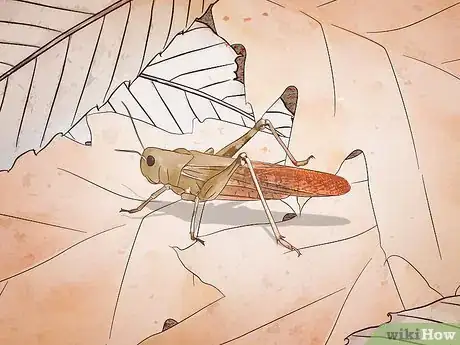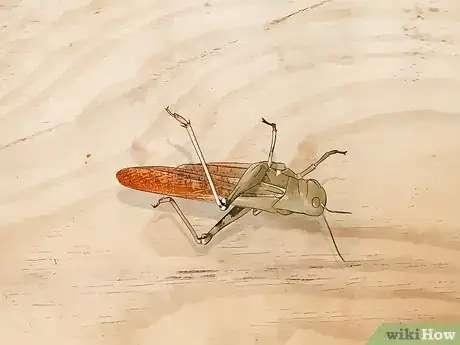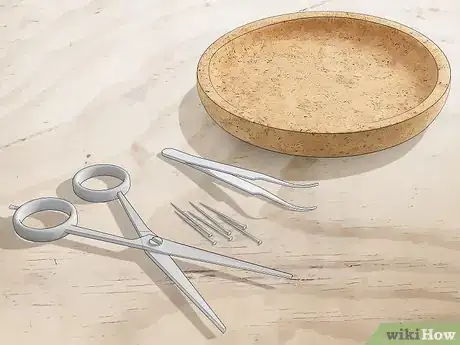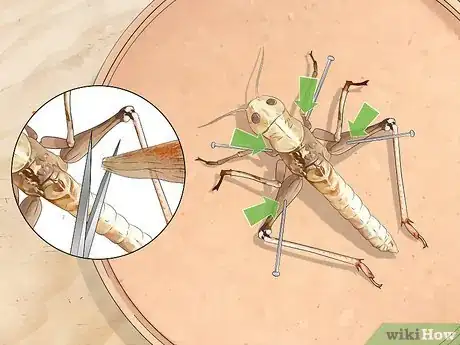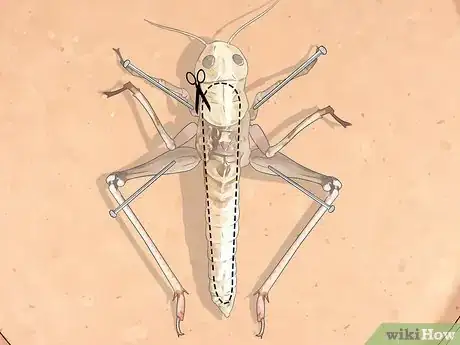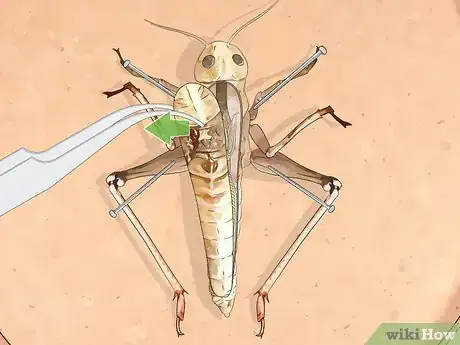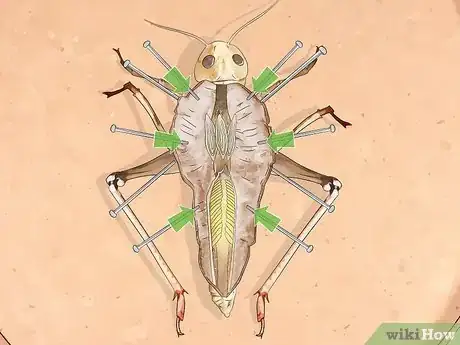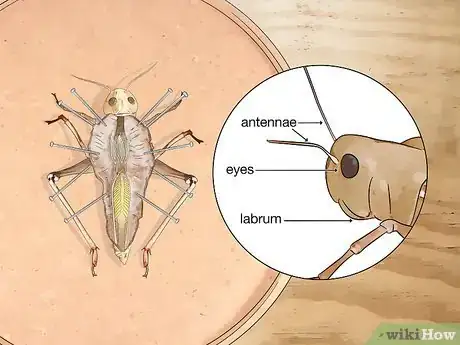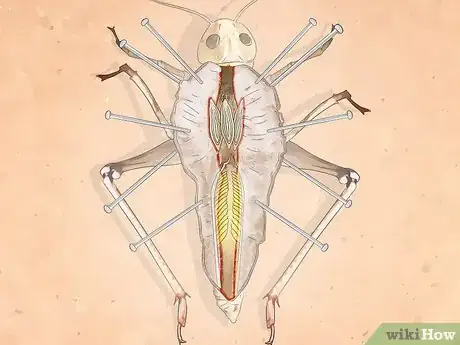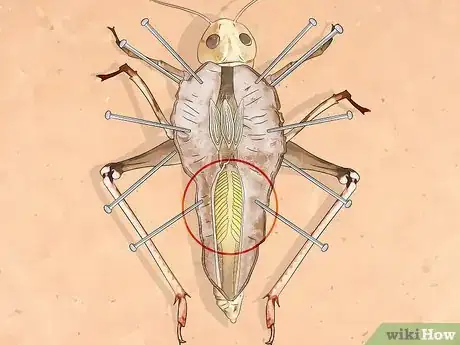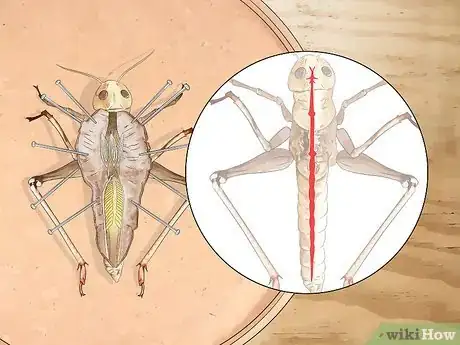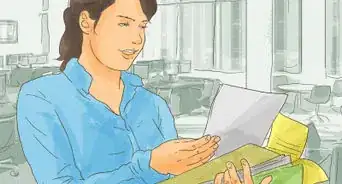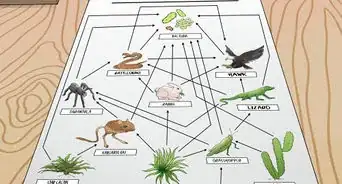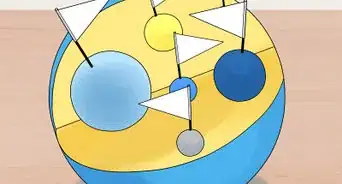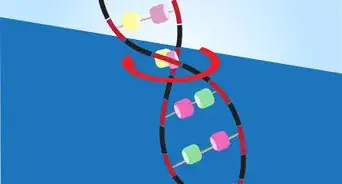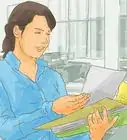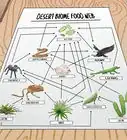This article was co-authored by Bess Ruff, MA. Bess Ruff is a Geography PhD student at Florida State University. She received her MA in Environmental Science and Management from the University of California, Santa Barbara in 2016. She has conducted survey work for marine spatial planning projects in the Caribbean and provided research support as a graduate fellow for the Sustainable Fisheries Group.
There are 14 references cited in this article, which can be found at the bottom of the page.
This article has been viewed 19,092 times.
Dissecting a locust will allow you to see how the body of an insect works. It’s an interesting project that can teach you a lot. While dissection can seem a bit messy, or perhaps unethical, it is a good educational exercise. Be careful when removing the tough exoskeleton so you can get a good look at what’s going on inside the insect.
Steps
Getting Ready to Dissect
-
1Acquire a locust. If you have locusts in your area, you might be able to catch one. You could also use a grasshopper as an alternative to a locust. If you’re doing this for a school project, the locust will likely be provided for you. If not, buy a locust dissection kit online so you have everything you need, from the insect to the tray and tools.
- Brace yourself. You might need to kill the locust and will need to cut it open. You might see some things you don’t expect. Some of it might be uncomfortable if you don’t like insects or gore However, to get the most of the experience, you should put aside these concerns. Remember that insects are among the most numerous animals on the earth. You are not threatening the species.[1]
-
2Make sure the locust is dead. It would be cruel (and difficult) to dissect a live animal. Although it may seem easy to kill insects, many methods take a long time, and in some cases, the insect may be alive even after it has stopped moving. There are several ways to prepare a humane "killing jar" for insects:
- Start with a glass jar about 15 cm (6 in) tall with a removable, airtight lid.[2] Mix enough plaster of Paris to cover the bottom 1 inch (2.5 cm) of the jar, along with a little water and 1 teaspoon (4.9 mL)of potassium cyanide, sodium cyanide, or ethyl acetate. These ingredients can be found in a laboratory store or online. Let the plaster harden, then drop the locust in and seal the lid. The insect usually becomes comatose after a few minutes, but wait 3 hours to ensure death.[3]
- Alternatively, use the natural source of cyanide found in Prunus laurocerasus (cherry laurel). Bruise the leaves well and drop them in a glass jar to a depth of 3⁄4 inch (1.9 cm). Add the locust and leave the jar closed for at least 2 or 3 days.[4]
- Always read and follow safety procedures when handling potentially dangerous chemicals. Many poisons used to kill insects can also cause harm to humans.
Advertisement -
3Collect the necessary gear. You will need scissors, tweezers, and needles to pin the locust. You will need a tray made of a soft permeable substance, like wax, cork, or softwood. You will place the pins through this surface to secure the locust to the tray.[5]
Cutting the Locust Open
-
1Secure the locust. Stab pins through the large back legs of the locust into the soft surface of the tray. Try to place the pins through the upper parts of the legs where there is more mass to keep the pin in place. This will hold secure the locust in place as you begin to dissect it.[6] [7]
- Pin down the locust so that its antennae are facing upward. You will want to cut along the back of the locust.
- If you find that the wings get in the way, cut them off with your scissors. Consider securing the locust first.[8]
- You can also pull gently on the bottom of the locust and put a pin through its abdomen to keep it stretched out during the procedure.
-
2Cut an oval-shaped incision on the locust's back. Starting at the top of the abdominal segment, cut down to the bottom of the locust's abdomen and back around in a circle to where you began the incision. To avoid damage to internal organs, try to pull up, away from the body with the scissors, as if you are lifting the skin. When you are done, there should be an oval-shaped incision that you can pull on to remove a section of the exoskeleton.[9] [10]
- The incision should begin near the top of the abdomen, continue down and around the abdomen, and back up to the head.[11]
Advertisement -
3Remove the exoskeleton. Once you have cut an oval-shaped incision, use tweezers to remove the “shield,” or exoskeleton. The heart should come off with the exoskeleton. The muscle should also be attached to the section of the exoskeleton that you remove; this will be necessary to reveal the internal organs.[12]
- If you want to inspect the heart, set the exoskeleton aside and look at it later.[13]
-
4Pin down both sides of the body. To better inspect the body, pin the left and right sides of the body to the tray. Open up the incision as far as is possible and insert pins through the exoskeleton on each side of the body and into the tray underneath. This will keep the incision open and easy to inspect.[14]
-
5Use a magnifying glass or microscope to inspect the locust. You will need some sort of assistance to better see the insides of the body. You might be surprised by some of the strange organs that a locust sports.[15]
- If you are a teacher, give your students a list of structures to find and identify, like the salivary glands, the gizzard, the midgut, the colon, and the rectum.
- Consider removing a small piece of the midgut and inspecting it under a microscope
- Allow students to compare their locusts. Some features, like air sacs, will vary considerably in size. Students might find that their insects look rather different.
Identifying Locust Anatomy During Dissection
-
1Recognize the 3 segments of the body. The locust's body is composed of 3 parts: the head, the thorax, and the abdomen. Understanding the difference is essential to locating many parts of the grasshopper's anatomy.
- The head includes the eyes and the antennae. The body narrows a bit at what looks like a neck, at which point the thorax begins.
- The thorax is the part of the body that the wings and legs attach to.
- The thorax ends at about the point where the wings attach to the body. From that point, the rest of the body is the abdomen.[16]
-
2Notice the parts of the head. Most of the head is visible before dissection. These include the eyes, which are located along the sides of the head. The antennae are two thin structures extending out of the top of the grasshopper's head. The labrum is located at the mouth of the grasshopper and acts as the upper lip, keeping food in the locust's mouth as it eats.[17]
-
3Sex your locust. To determine the sex of your locust, inspect the end of the abdomen. The end of a female abdomen will narrow to a point that is used to lay eggs. The end of the male abdomen will be rounded and point upward.[18]
-
4Find the digestive system. The digestive system runs from the mouth of the locust to its anus. The digestive system is responsible for processing food that the locust consumes. It will run through the center of the locust and constitutes its largest organ system.
- The first large structure in the digestive system is the crop. It is one of the largest organs and is a big, oval-shaped structure close to the mouth. Its function is to store food before it is digested.
- After the crop, the stomach is the next large structure in the digestive system. It is the second of 4 oval-shaped organs in the system. Between the stomach and the crop are the gastric caeca, which are shaped somewhat like the petals of the flower. These contain bacteria that are used in the process of digestion.[19]
- The third, smaller oval structure in the digestive system is the intestine. Between it and the stomach is thin vein-like structures known as the Malpighian tubule. This is used to process liquid into the urine.[20]
- After the intestine, the digestive system narrows into a small tube, then opens back up again to a small, oval structure, connecting to the anus. That is the rectum. This is where digested food is released from the body as feces.
-
5Locate the reproductive system. The reproductive system will be above the large intestine, between it and the stomach. Ovaries will contain yellow, oval-shaped eggs. In contrast, if your locust is a male, you should be looking for white testes.
- Both of these structures are small and can be difficult to see, especially the male testes.
-
6Inspect the circulatory system. The heart was likely removed with the exoskeleton during the dissection. The heart is composed of several small chambers that run along the length of the locust’s body. Each of these heart chambers will be connected by Ostia, openings that allow blood to circulate between the heart chambers.
Warnings
- Some embalming chemicals are toxic. Refrain from direct skin contact or bringing the insect into contact with fire. Use gloves or forceps to manipulate the locust.[22]⧼thumbs_response⧽
References
- ↑ http://www.bbc.com/earth/story/20150211-whats-the-most-dominant-life-form
- ↑ http://www.nzdl.org/gsdlmod?e=d-00000-00---off-0hdl--00-0----0-10-0---0---0direct-10---4-------0-1l--11-en-50---20-about---00-0-1-00-0--4----0-0-11-10-0utfZz-8-00&a=d&cl=CL1.10&d=HASHd1edbf77fbe3fa2e5e3da5.11.3
- ↑ https://books.google.com/books?hl=en&lr=&id=QHYTDAAAQBAJ
- ↑ http://www.cleapss.org.uk/attachments/article/0/L227.pdf?Primary/Resources/Guides/
- ↑ http://www.nuffieldfoundation.org/practical-biology/dissection-ventilation-system-locust
- ↑ http://www.nuffieldfoundation.org/practical-biology/dissection-ventilation-system-locust
- ↑ http://www.biologyjunction.com/grasshopper_dissection.htm
- ↑ https://www.youtube.com/watch?v=e-yKVs_5AsA
- ↑ http://www.iroquoiscsd.org/cms/lib/NY19000365/Centricity/Domain/77/7_chapter_37_lab_grasshopper_dissection.pdf
- ↑ http://www.nuffieldfoundation.org/practical-biology/dissection-ventilation-system-locust
- ↑ http://www.nzdl.org/gsdlmod?e=d-00000-00---off-0hdl--00-0----0-10-0---0---0direct-10---4-------0-1l--11-en-50---20-about---00-0-1-00-0--4----0-0-11-10-0utfZz-8-00&a=d&cl=CL1.10&d=HASHd1edbf77fbe3fa2e5e3da5.4.fc
- ↑ http://www.iroquoiscsd.org/cms/lib/NY19000365/Centricity/Domain/77/7_chapter_37_lab_grasshopper_dissection.pdf
- ↑ http://www.nuffieldfoundation.org/practical-biology/dissection-ventilation-system-locust
- ↑ https://www.youtube.com/watch?v=e-yKVs_5AsA
- ↑ http://www.nuffieldfoundation.org/practical-biology/dissection-ventilation-system-locust
- ↑ http://www.biologyjunction.com/grasshopper_dissection.htm
- ↑ http://www.brisbaneinsects.com/brisbane_insects/GrasshopperHead.htm
- ↑ http://www.biologyjunction.com/grasshopper_dissection.htm
- ↑ http://entomology.osu.edu/~bugdoc/Ent101/101Anatomy/101Anatomy_05.htm
- ↑ http://www.britannica.com/science/malpighian-tubule
- ↑ http://www.nzdl.org/gsdlmod?e=d-00000-00---off-0hdl--00-0----0-10-0---0---0direct-10---4-------0-1l--11-en-50---20-about---00-0-1-00-0--4----0-0-11-10-0utfZz-8-00&a=d&cl=CL1.10&d=HASHd1edbf77fbe3fa2e5e3da5.11.3
- ↑ http://www.nuffieldfoundation.org/practical-biology/dissection-ventilation-system-locust
